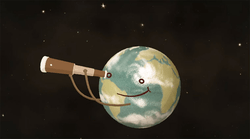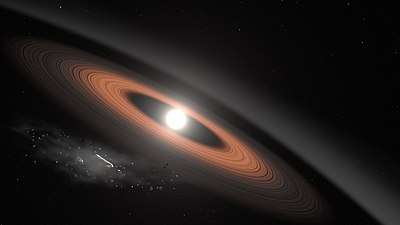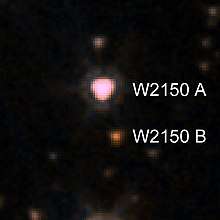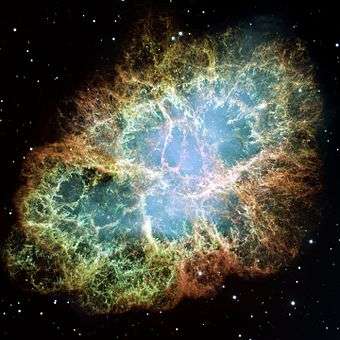Backyard Worlds
Backyard Worlds: Planet 9 is a NASA-funded citizen science project which is part of the Zooniverse web portal.[1] It aims to discover new brown dwarfs and other low-mass stars, some of which might be among the nearest neighbors of the Solar System, and might conceivably detect Planet Nine. The project's principal investigator is Marc Kuchner, an astrophysicist at NASA's Goddard Space Flight Center.[2]
 | |
Type of site | Citizen science project |
|---|---|
| Available in | English |
| URL | www |
| Commercial | No |
| Registration | Optional |
| Launched | 15 February 2017 |
| Current status | Online |
Origins
Backyard Worlds was launched in February 2017 shortly before the 87th anniversary of the discovery of Pluto,[3] which until its reclassification as a dwarf planet in 2006 was considered the Solar System's ninth major planet. Since that reclassification evidence has come to light that there may be another planet located in the outer region of the Solar System far beyond the Kuiper belt, most commonly referred to as Planet Nine. This hypothetical new planet would be located so far from the Sun that it would reflect only a very small amount of visible light, rendering it too faint to be detected in most astronomical surveys conducted to date.[4][1] Models of the conjectured planet's atmosphere suggest however that methane condensation could in some cases make it detectable in infrared images captured by the Wide-field Infrared Survey Explorer (WISE) space telescope.[5] Due to the effects of proper motion and parallax Planet Nine would appear to move in a distinctive way between images taken of the same patch of sky at different times. In addition to Planet Nine, other objects, such as nearby brown dwarfs, would also be seen to move.
The citizen scientists search through a flip book-style animation of specially processed infrared images captured by WISE, taken with filters at the wavelengths of 3.4 and 4.6 micrometers. The images contain instrumental artifacts and are noisy, which hampers the use of automated image processing software and makes the task ideal for exploiting human visual recognition capabilities.[1][2]
The project has been awarded a grant from NASA's Astrophysics Data Analysis Program which will fund it until 2020.[6]
In November 2018, the project was "rebooted", with new images and reduced noise.[7]
Project status
In December 2017, seven new brown dwarfs were confirmed, as well as two cool subdwarfs. The spectral types of the new brown dwarfs were T0, T2.8, T5, T6, T6.5, and two of type T8. In addition, there were 337 brown dwarf candidates awaiting spectra for confirmation.[8]
As of the first anniversary of the project in February 2018, the project had discovered 17 brown dwarfs and two cool subdwarfs. The coldest object discovered is of spectral type T9, which raises hopes of discovering type Y dwarfs in the future. In addition, a spectrum was also taken of one possibly variable object of unknown type that does not actually exhibit proper motion. There are 432 objects of interest awaiting verification, of which 38 are Y dwarf candidates.[6]
In July 2018 an update on the project's blog stated that in total 42 brown dwarfs had been spectroscopically confirmed from a list of 879 candidates. Fourteen of those confirmed are closer to the solar system than 20 parsecs (65 light-years).[9]
As of July 2019, there are 1305 candidate objects to be followed up, of which there are 131 confirmed objects: 70 dwarfs of type T and 61 dwarfs of type L. Of the candidate and confirmed brown dwarfs, 55 of them are closer to the solar system than 20 parsecs. There are also roughly 100 Y dwarf candidates.[10]
Published discoveries
WISEA 1101+5400
In June 2017, it was announced that Backyard Worlds had made its first official discovery: a brown dwarf designated WISEA 1101+5400, of spectral type T5.5 and located 34 parsecs (111 light years) from Earth. A paper announcing the discovery was accepted for publication in Astrophysical Journal Letters, and Backyard Worlds now holds the record among all Zooniverse projects as having the shortest time from project launch to first publication.[11][12]
LSPM J0207+3331

In October 2018, a participant in the project discovered LSPM J0207+3331, the oldest and coldest known white dwarf to host a circumstellar disk despite being 3 billion years old. The disk consists of two rings at different temperatures. This star has been studied with the Keck telescope and is the object of ongoing research.[13][14]
W2150AB

At the 235th meeting of the American Astronomical Society in January 2020 the discovery of the wide brown dwarf binary W2150AB was presented by Jacqueline Faherty. The L1+T8 co-moving system is separated by 341 au. The system has the lowest gravitational binding energy for a brown dwarf binary that is not young and with the primary being a L-dwarf or later.[15][16]
WISE J0830+2837
The discovery of WISE J0830+2837, the first Y-dwarf discovered by volunteers was also presented at the 235th meeting by project scientist Daniella Bardalez Gagliuffi. The Y-dwarf was not detected by the Hubble Space Telescope, but the Spitzer Space Telescope did detect this object due to it observing at longer wavelengths of light. It is about 11.2 parsec (36.5 light years) distant and has a temperature of about 350 K (77 °C or 170 °F). This estimated temperature would place it between the majority of the Y-dwarf population so far identified and WISE 0855−0714, the coldest object of this type known.[17] A summary of the current status of the project was shown at the meeting. Those include 1503 L, T and Y dwarf candidates. At total there were 221 spectra taken.[18]
WISEA J041451.67-585456.7 & WISEA J181006.18-101000.5
A paper was published in the Astrophysical Journal in July 2020 reporting the discovery of two unusual brown dwarfs; WISEA J041451.67-585456.7 was discovered by Backyard Worlds volunteers and WISEA J181006.18-101000.5 by the NEOWISE Proper Motion Survey, also with the aid of a Backyard Worlds citizen scientist.[19] These high-proper motion objects display unique colors and near-infrared spectra that do not fully match current models. The models producing the best matches to the spectra imply the brown dwarfs have [Fe/H] ≤ -1 , meaning they have extremely sub-solar metallicity, containing far lower amounts of elements heavier than Hydrogen or Helium compared to the Sun. The estimates from the model spectra suggest that these objects have up to 30 times less iron than typical for known brown dwarfs.[20] The authors argue that the spectral properties combined with the estimated low temperatures of approximately 1200-1400 K make these brown dwarfs likely the first extreme subdwarfs of the T spectral class (esdTs) to be identified. The extremely low metallicity implies these brown dwarfs are very old, approximately 10 billion years, as the galaxy at this time would have featured lower quantities of heavy elements. This provides evidence that substellar objects were able to form in the low metallicity environment of the Milky Way's past.[21]
See also

Zooniverse projects:
Notes
References
- "NASA wants you to help find a new planet". CNN. 16 February 2017. Retrieved 26 December 2017.
- "Hunt for Planet 9: how you can help NASA search for brown dwarfs and low-mass stars". The Christian Science Monitor. 17 February 2017. Retrieved 26 December 2017.
- "Backyard Worlds: Planet 9". nasa.gov. 13 March 2017. Retrieved 24 December 2017.
- Achenbach, Joel; Feltman, Rachel (20 January 2016). "New evidence suggests a ninth planet lurking at the edge of the solar system". The Washington Post. Retrieved 20 January 2016.
- Fortney, Jonathan J.; et al. (2016). "The Hunt for Planet Nine: Atmosphere, Spectra, Evolution, and Detectability". The Astrophysical Journal Letters. 824 (2): L25. arXiv:1604.07424. Bibcode:2016ApJ...824L..25F. doi:10.3847/2041-8205/824/2/L25.
- "We Love You! And Happy Anniversary!". Blog.backyardworlds.org. 14 February 2018. Retrieved 14 February 2018.
- "The Reboot Is Here!". Blog.backyardworlds.org. 16 November 2018. Retrieved 22 February 2019.
- "Snow White and the Seven New Confirmed Brown Dwarfs". Blog.backyardworlds.org. 22 December 2017. Retrieved 31 December 2017.
- "42 Confirmed Brown Dwarfs and Counting". Blog.backyardworlds.org. 11 July 2018. Retrieved 13 July 2018.
- "One Hundred Thirty-One Brown Dwarfs". Blog.backyardworlds.org. 15 July 2019. Retrieved 24 July 2019.
- "Our First Paper: the Discovery of Brown Dwarf WISEA 1101+5400". Blog.backyardworlds.org. 8 June 2017. Retrieved 6 October 2017.
- Kuchner, Marc J.; et al. (2017). "The First Brown Dwarf Discovered by the Backyard Worlds: Planet 9 Citizen Science Project". The Astrophysical Journal. 841 (2): L19. arXiv:1705.02919. Bibcode:2017ApJ...841L..19K. doi:10.3847/2041-8213/aa7200.
- "The Crystal Ball White Dwarf". Blog.backyardworlds.org. 19 February 2019. Retrieved 22 February 2019.
- "Volunteer Discovers Record-Setting White Dwarf Star". NASA.gov. 19 February 2019. Retrieved 22 February 2019.
- Faherty, J.; Goodman, S.; Caselden, D.; Colin, G.; Kuchner, M.; Meisner, A.; Gagné, J.; Schneider, A.; Gonzales, E.; Bardalez Gagliuffi, D.; Logsdon, S.; Allers, K.; Burgasser, A.; The Backyard Worlds: Planet 9 Collaboration (January 2020). "Citizen Scientists discover a very low mass, wide co-moving brown dwarf system". AAS. 52: 352.07. Bibcode:2020AAS...23535207F.
- Faherty, Jacqueline K.; Goodman, Sam; Caselden, Dan; Colin, Guillaume; Kuchner, Marc J.; Meisner, Aaron M.; Gagné, Jonathan; Schneider, Adam C.; Gonzales, Eileen C.; Gagliuffi, Daniella C. Bardalez; Logsdon, Sarah E.; Allers, Katelyn; Burgasser, Adam J.; The Backyard Worlds Planet 9 Collaboration (2020). "WISE2150-7520AB: A very low mass, wide co-moving brown dwarf system discovered through the citizen science project Backyard Worlds: Planet 9". The Astrophysical Journal. 889 (2): 176. arXiv:1911.04600. Bibcode:2020ApJ...889..176F. doi:10.3847/1538-4357/ab5303.
- Bardalez Gagliuffi, D.; Faherty, J.; Collaboration, Backyard Worlds: Planet 9 Citizen Science; Schneider, A.; Meisner, A.; Caselden, D.; Colin, G.; Goodman, S.; Kirkpatrick, J.; Kuchner, M.; Gagné, J.; Logsdon, S.; Burgasser, A.; Allers, K.; Debes, J.; Wisniewski, J. (January 2020). "WISE J0830+2837: the first Y dwarf from Backyard Worlds: Planet 9". AAS. 52: 132.06. Bibcode:2020AAS...23513206B.
- Greco, Jennifer (7 January 2020). "Awesome talk by @jfaherty about the results from the Backyard Worlds project! Lots of new brown dwarfs being discovered! #AAS235pic.twitter.com/U2t2KxQvuf". @astrogrecoj. Retrieved 8 January 2020.
- Schneider, Adam C.; Burgasser, Adam J.; Gerasimov, Roman; Marocco, Federico; Gagné, Jonathan; Goodman, Sam; Beaulieu, Paul; Pendrill, William; Rothermich, Austin; Sainio, Arttu; Kuchner, Marc J.; Caselden, Dan; Meisner, Aaron M.; Faherty, Jacqueline K.; Mamajek, Eric E.; Hsu, Chih-Chun; Greco, Jennifer J.; Cushing, Michael C.; Kirkpatrick, J. Davy; Bardalez-Gagliuffi, Daniella; Logsdon, Sarah E.; Allers, Katelyn; Debes, John H.; Collaboration, Backyard Worlds: Planet 9 (July 2020). "WISEA J041451.67-585456.7 and WISEA J181006.18-101000.5: The First Extreme T-type Subdwarfs?". ApJ. 898: 77. arXiv:2007.03836. doi:10.3847/1538-4357/ab9a40.
- "Two Bizarre Brown Dwarfs Found With Citizen Scientists' Help". NASA.gov. 10 July 2020. Retrieved 11 August 2020.
- "Citizen Scientists Help Discover "Weird" Brown Dwarfs". Skyandtelescope.org. 20 July 2020. Retrieved 11 August 2020.